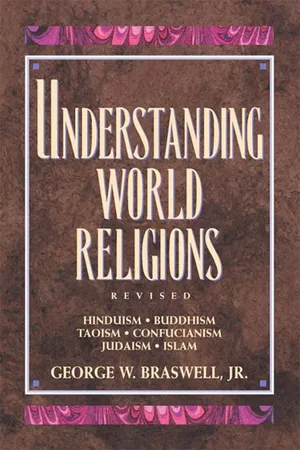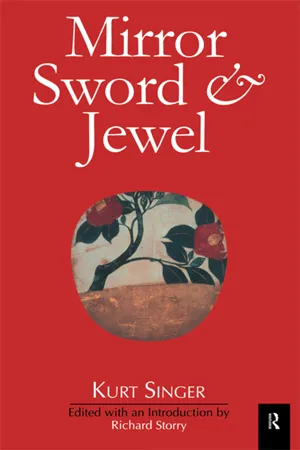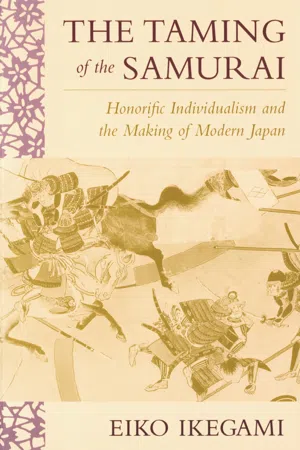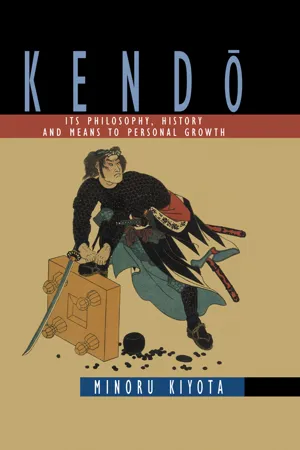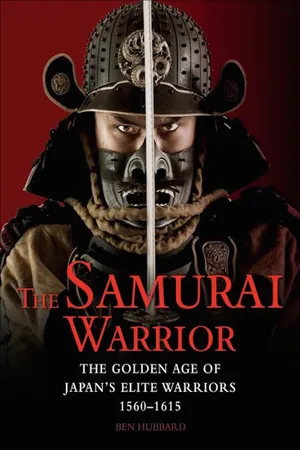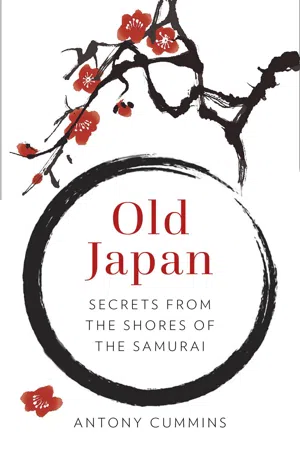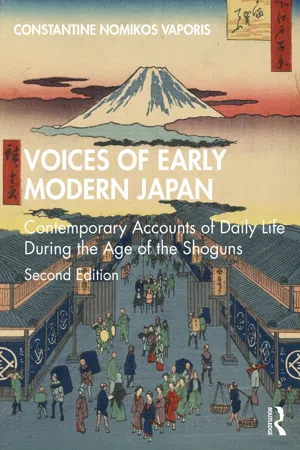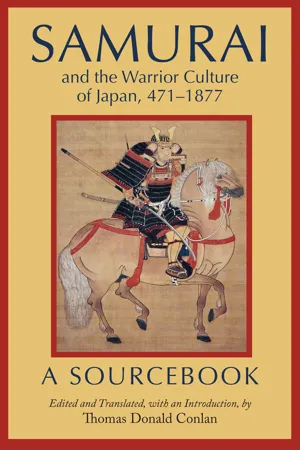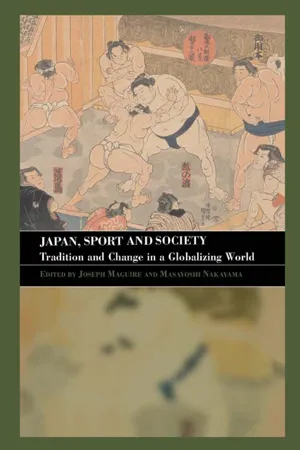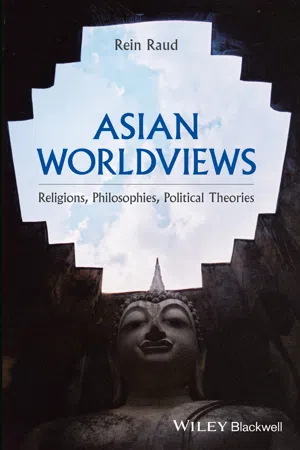History
Samurai Culture
Samurai culture refers to the way of life, values, and traditions of the Japanese warrior class during the feudal period. It is characterized by a code of honor known as Bushido, which emphasized loyalty, self-discipline, and ethical behavior. Samurai were skilled in martial arts and played a significant role in shaping Japan's history and society.
Written by Perlego with AI-assistance
Related key terms
11 Key excerpts on "Samurai Culture"
- eBook - ePub
- George Braswell(Author)
- 1994(Publication Date)
- B&H Books(Publisher)
In descending order were the shogun, the feudal lords who ruled over the individual fiefdoms, the samurai or bushi warriors, and the peasant farmers, artisans, and merchants. Each level was to perform its explicit duties and to give loyalty to one another. In this system the military (samurai) became very prestigious, and the Bushido code (way of the warrior) became the idealized way of life. This code promoted loyalty and obedience from one group to the other, emphasizing the virtues of politeness, honor, courage, and reserve. The samurai spirit became one of ultimate loyalty to one's emperor and one's nation. One would give one's life for the nation. Or one would take one's life before dishonoring family or nation through a failure or a defeat. “Saving face” is important among the Japanese. Other influences Of course, Confucianism and its loyalty-obedience patterns in the five great relationships added support to Japanese values of group identity and leader-follower roles. Mayahana Buddhism, through its encouragement of devotion to the Buddha, lent its influence to group dependence on leadership. One may note the strong sense of group formation in Japanese society. Groups like the family, the clan, or the nation are thought of as natural arrangements blessed with the sacred quality. The head of each group relates its members to divine ancestors and to protective deities. The father of the family or the elder of the clan relates them to ancestor worship. The village elder or priest relates its members to local kami. The emperor of the nation relates all the people to the imperial ancestors and deities. Individuals exist because of the continuous flow of blessings from the ancestors and deities through the various heads of the groups. In return for those blessings individuals work within the group to repay those blessings and to sacrifice themselves for the group if necessary - eBook - ePub
- Kurt Singer(Author)
- 2013(Publication Date)
- Routledge(Publisher)
Anesaki goes on: “Advice was given to the heirs of military leaders as to administration of feudal territories, treatment of soldiers, care of provisions, and as to codes of honour in peace and war. In short, religious beliefs and worldly wisdom, spiritual training, military discipline, moral ideals and practical counsels were fused into the one principle of the warrior’s honour. The principle and practice of bushido, the Way of the Warrior, found here definite formulation, and these teachings were destined to sway the ruling classes throughout coming centuries. Some of these documents exercised an influence beyond the limits of the clans and families and became in some respects a national heritage.” 5 The house-laws of military clans, including those of the ruling family of the Tokugawa clan, are the linear descendants of these early spiritual legacies. To withhold from them the name of code or institution is only possible if the use of these terms is unduly restricted to rigid systems resembling the Deuteronomium, the Institutions of Justinian, or the Code Napoleon. The contents of the Samurai-laws retained a certain fluidity and plasticity; this kept them alive and able to survive in periods of violent change and revolutionary ferment. To deny that they had a decisive influence on the formation of the Japanese character and of Japanese thought and society is to allow oneself to be blinded by one’s own scepticism. Neither Hall Chamberlain nor Sansom, although ready to discount much that is contained in hyperbolical eulogies, has carried his disbelief in any superior congenital moral quality of the Japanese so far as to declare the ethics of the samurai to be mere legend, artificially constructed in the Meiji period for political purposes. It was a pattern of ideas and ideals clothed with the authority first of the clan head or the ruler, later of the military scholar and patriotic leader - eBook - ePub
The Taming of the Samurai
Honorific Individualism and the Making of Modern Japan
- Eiko Ikegami(Author)
- 1997(Publication Date)
- Harvard University Press(Publisher)
In the meantime, some samurai, in particular those who lived in prosperity far from Kyoto, acquired a greater sense of confidence about their own military lifestyle. And their distinctive culture, based upon their identity as military specialists, sometimes made a good impression on the people in the capital city. Even though their manners were simple and unpolished, these samurai with their culture of honor appeared to be men of principle, at least compared with the crafty and underhanded courtier-politicians.An important asset of the Samurai Culture was a distinct military achievement-oriented attitude, brought into late ancient Japan through the samurai’s military professionalism. In contrast, the ancient Japanese state, centering around the emperor’s court, did not fully adopt a meritocratic system of recruiting elites, as had its Chinese model. Instead, the higher governmental positions continued to be occupied by men born into the limited bloodlines of the aristocracy. Conversely, though samurai houses were also largely considered hereditary, the very nature of military professionalism, which required constant demonstration and improvement of military efficacy, prevented the samurai from taking their inherited positions for granted.In general, Konjaku monogatari contains many descriptions of the lively atmosphere of the samurai’s yakata (residence house), implicitly contrasting it with the bland, passive existence of the aristocracy in Kyoto.52 The samurai are usually described as uncomplicated, energetic, straightforward men who would risk their lives in order to keep their good name as warriors. For example, as Konjaku monogatari recounts, a mighty samurai, Taira no Koremochi, usually called Yogo, when on the verge of defeat by an unexpected attack did not run for the hills as his retainers advised him to do. Yogo said to them, “It would be the shame (haji) of my descendants,” and sprang to his feet with determination. His unexpected courageous counterattack routed his enemies. Yogo thereafter increased his reputation and was renowned as the strongest samurai in the eastern region.53 - Chapter IVThe Development of Bushidō , The Code of the Samurai1 The Historical Development of BushidōSince bushidō means ‘the way of the samurai, ’ the term ‘samurai’ first needs to be clarified. If samurai is defined as warriors employed for the defense of the community, like those in prehistory who served the Yamato clan in its territorial expansions, or those of the early historical period who served as guards to the aristocracy, then the samurai, like warriors in any other society, have their origin in very early times. But in prehistorical and earliest historical times, Japanese warriors existed under a political system governed by the aristocracy. So while they served the aristocracy, they did not develop a distinct sense of identity. Only when they emerged as the guardians of manorial properties in the provinces, when distinct ties of allegiance developed between the head of the manor and his retainers, and when their position became hereditary, did their social status become distinct. Their emergence as a socially identifiable group dates from the late Heian period (the mid-twelfth century) during the time of the great military clans of the Genji and Heike. From that time until the beginning of Japan’s emergence as a modern state (1868), the samurai ruled Japan for some 800 years. Over this period their world view and their code of conduct naturally underwent change.The purpose of this chapter is to describe bushidō by relating historical episodes and to categorize the themes of these episodes. In doing so we need to start from the late Heian period, for these episodes are derived from battles that took place among the Genji and Heike samurai in the late Heian period. Thus bushidō
- eBook - ePub
The Samurai Warrior
The Golden Age of Japan's Elite Warriors 1560–1615
- Ben Hubbard(Author)
- 0(Publication Date)
- Amber Books Ltd(Publisher)
In this way, the whole notion of bushidō, even among those legendary warriors who valiantly beheld its virtues, is riddled with contradictions. Simply, there were no guarantees that those cultivated samurai, well-versed in etiquette and tradition, would actually behave honourably. Honour was one of the key virtues of the bushidō code, but it often gave way to ambition and self-interest. The codes of bushidō were also sometimes inconsistent in their messages about honour. Those considered the best warriors, for example, were the ones who had put the conditions of warfare to their advantage. Samurai were encouraged to be opportunists in war – such as fighting with the sun at their back so it would blind their opponent – but they were also paradoxically expected to conduct a fair fight.Arquebuses were notoriously clumsy to fire and reload. Well-organized armies employed assistants to help with gunpowder and ammunition.Loyalty was another elusive ideal, although in theory it was the pre-eminent quality of the samurai, prized above all else. Any worthy warrior would follow his master into death or lay down his life for him. But loyalty to whom, or what, was another question. The Emperor was considered to be the most important man in Japan, until the provincial clans decided they did not want to serve him. He was then replaced with a Shōgun, or regent. But Shōguns, too, were capable of disloyalty. Samurai would follow their Shōgun or clan leader to the ends of the earth, but their fidelity was often rewarded with death or betrayal. Loyalty to one’s clan was thought an essential, but brothers would not hesitate to kill each other to better their position.Samurai warriors were expected to die an honourable death by the sword. Those defeated in battle could retain their honour by committing seppuku.The stories of the greatest samurai heroes are therefore parables of loyalty to one’s clan, one’s Emperor, one’s master and oneself, which don’t reflect the darker reality. It is the complex relationship with this topmost bushidō virtue that defined the legacies of these samurai, but their actions often confuse rather than clarify the ethos of bushidō.Takeda Shingen was among the last of the old guard of samurai gentlemen. He is seen here (top centre) in a war council with his generals. - eBook - ePub
Old Japan
Secrets from the Shores of the Samurai
- Antony Cummins(Author)
- 2018(Publication Date)
- The History Press(Publisher)
The Samurai
The Way of the Warrior
Everybody has heard of bushido – the way of the warrior – but many people think of it as a modern invention because a man called Nitobe Inazo wrote the book Bushido in English in 1900 in response to questions about society in Japan. However, that is simply not true. While the details of this chivalric code may have changed over time, the concept of bushido dates back many hundreds of years and is sometimes referred to simply as budo , a word that today has come to mean martial arts. The earliest record I have personally found for the term bushido is in a c .1495 collection of poetry by Monk Sogi. The ideograms for bushido are 武士道 but, when written down in poem form, the word bushi , meaning warrior, changes its pronunciation to mononofu and do changes to michi , so that the correct amount of syllables are used in the poem. This means that while the ideograms and meaning are the same, the reading changes from bushido to mononofu no michi .The c .1495 poem goes thus:Hakanaki mono wa, Mononofu no michi Ta ga tame no Na nareba mi yori Oshimran A thing of uncertainty Is the way of the warrior For whose glory does a man careless for life Than for honourThe Etiquette of Swords
A samurai had to take his katana off his waist when he entered a house and hold it in hand. It was then placed in the correct storage space. At times he also kept it at his side.The Samurai at Dinner
A retainer was a samurai who served another (normally samurai) master. They formed a bond of master–retainer in which the lower person served with obedience, forming a gap between them at societal level. However, when dining together, the conversation was free; the retainer might talk to whomever he wished and be familiar and merry. When the meal was over, his attitude returned to one of service and the gap was established again. - eBook - ePub
Voices of Early Modern Japan
Contemporary Accounts of Daily Life During the Age of the Shoguns
- Constantine N. Vaporis, Constantine Vaporis(Authors)
- 2020(Publication Date)
- Routledge(Publisher)
The removal of samurai from the land and their resettlement in castle towns resulted in a profound transformation of the group, from a feudal military class with close ties to the land to an economically dependent, urban-based, under-employed elite. Due to the large size of the samurai status group (5–7 percent of the population), the vast majority of samurai held no bureaucratic posts, but government service remained highly desirable and much sought after. Accordingly, a formal, Confucian-based education became essential, such that by the end of the seventeenth century an illiterate samurai was the subject of ridicule. While warrior traditions were kept alive, the daily life of a Tokugawa samurai would have seemed quite odd to his predecessor in the Warring States period. Residing in castle towns and paid largely in rice from the daimyo’s warehouses, a samurai was unlikely to have had much opportunity to interact with peasants. In fact, samurai had to have official permission just to travel to the countryside. His life in the city became subject to rules that regulated his behavior and work. As part of a daimyo’s retainer band, samurai became part of a stratified and elaborate civil administrative body that ran the machinery of government for urban, rural, temple and shrine, financial, and social affairs. Under conditions of peace, loyalty to the lord came to be defined as bureaucratic service rather than bravery on the battlefield.The Great Peace for samurai created tensions between a long and proud martial tradition and the newfound reality of bureaucratic service. They were urged by legal codes and Confucian scholars to follow the twin ways (ryōdō ) of military training (bu ) and book learning (bun ). In the long run, however, military training suffered, despite the periodic reforms undertaken by the shogunate and domain governments to improve military skills. Samurai could hone their martial skills in practice halls, but their right to use their swords was highly circumscribed by legal code. These tensions between samurai as military men and as a civil administrative elite came to a head in the famous Akō Incident in 1702, when 47 masterless samurai followed the unwritten code of the warrior in avenging the death of their lord, but in doing so broke shogunal law. After lengthy debate among Tokugawa officials, an accommodation was reached: the law of the land was upheld by punishing the men with seppuku - eBook - ePub
- Thomas Donald Conlan(Author)
- 2022(Publication Date)
- Hackett Publishing Company, Inc.(Publisher)
SECTION XIThe Samurai of the Tokugawa Era (1603–1867)With the onset of peace in Japan, debates arose over what to do with the samurai , and the warrior culture more generally. Some early thinkers, such as Kumazawa Banzan (1619–91) (see Kumazawa Banzan, “Abolition of the Separate Soldier Class,” p. 267), argued that warriors must be tied to the land in order to be effective fighters. To Banzan, life in newly founded capital cities made the samurai soft and ineffectual. The autobiography of Confucian scholar Arai Hakusei (1657–1725) (Arai Hakuseki’s Autobiography , p. 272), ably recounts changes in samurai attitudes and status by describing his father and grandfather, who lost his land holdings. In addition, Hakuseki’s account of a fugitive samurai reveals that warrior violence still lingered for decades after the establishment of a Tokugawa peace.Yamamoto Tsunetomo (1659–1719) wrote privately that the way of the samurai was found in death; he advocated that samurai focus on that which they could control—their end (see The Book of the Samurai Hagakure by Yamamoto Tsunetomo, p. 276). He also voiced skepticism regarding earlier morals and beliefs. Other samurai relied on ruses and the threat of committing suicide to squeeze taxes out of peasants ( Musui’s Story: The Autobiography of a Tokugawa Samurai , p. 280). Fukuzawa Yukichi (1835–1901), a samurai who gained knowledge of European affairs, was critical of samurai ideals and mores, rejecting most of them entirely (see The Autobiography of Yukichi Fukuzawa, p. 291). Shiba Gorō (1860–1945), the young son of a samurai family, fought valiantly, and his mothers and sisters killed themselves in the battles of 1869, which closely followed the collapse of the Tokugawa regime (see The Testament of Shiba Gorō , p. 292). This section closes with two warriors’ petitions, written in an archaic fourteenth-century style, for reward (Two Petitions for Reward Submitted in 1869, p. 297).{272} 1. Excerpts from Arai Hakuseki’s - eBook - ePub
Japan, Sport and Society
Tradition and Change in a Globalizing World
- Joseph Maguire, Masayoshi Nakayama(Authors)
- 2004(Publication Date)
- Routledge(Publisher)
The various skills that warriors were required collectively to master, as bujutsu, began to develop independent cultural identities. The sword-hunt decree of 1588 disarmed all the farmers and only warriors were granted the privilege of carrying swords. Thus, swords became a symbol of the warrior class and kenjutsu (swordsmanship) assumed an important role in bujutsu (Sakai, 2003: 29). The Edo period, between 1603 and 1867, was a relatively stable age under the rule of a warrior family (the Tokugawas). The Tokugawa regime established a social hierachy and people were divided into four classes called shi-no-ko-sho, that is: warrior, farmer, artisan, merchant. In 1639, the Tokugawa regime also adopted a policy of national seclusion, the exception being highly restricted trade with the Dutch and Chinese. Because of this seclusion, Japan developed its own practices such as kabuki, ukiyo-e, sado and ikebana. Martial arts in this period became less valued in terms of their practical use. Japan had political stability and members of the warrior class could no longer change their social status by using their combat skills. Instead, martial arts developed to be part of the warrior class’s education. In the same way as in other cultural activities, martial arts split into hundreds, or even thousands, of schools according to the different weapons used and the masters’ ideas. Each martial art was developed independently. The main method of practice was kata (set form practice) with real swords, and after the middle of the eighteenth century, a practice method that used bamboo and wooden swords, with armour, became popular. Martial arts were less violent, and became more sport-like. Martial arts were becoming civilized. The late Edo period was socially stable and bujutsu thus took on an educational role. It had a philosophical dimension and a refined code of conduct (bushido) for warriors, as well as maintaining the skills formerly used in battle - Karl F. Friday(Author)
- 2004(Publication Date)
- Routledge(Publisher)
A samurai's reputation, honor and pride were almost tangible entities that took precedence over all other obligations. As a thirteenth-century commentary enumerating the “seven virtues of a warrior” concludes, “To go forth to the field of battle and miss death by an inch; to leave behind one's name for myriad generations; all in all, this is the way.” Slights to reputation or honor were often catalysts to belligerence and bloodshed. Warriors might refuse orders from their superiors, risk the loss of valuable retainers, and even murder men to whom they owed their lives, all for the sake of their reputations. 4 Honor – or conversely, shame – could reach beyond the warrior himself, and even beyond his lifespan. Bushi could prosper through the inherited glory of their ancestors or suffer the stigma of their disgrace. Thus, even a warrior's life could be of less consequence to him than his name and image, and we find in accounts of battles numerous sketches of warriors choosing to sacrifice themselves in order to enhance their reputations or those of their families. 5 One must, however, be careful not to make anachronistic or ethnocentric assumptions about the nature of honor, or about the sort of battlefield conduct it might be expected to have engendered. For, while honor and shame were central to the self-perception of early bushi, honor turned on a warrior's military reputation, which turned first and foremost on his record of victories. Early medieval Japanese concepts of honor and of honorable conduct in battle were flexible enough to permit successful warriors to rationalize almost any sort behavior. Expediency, self-interest, and tactical, strategic or political advantage proved to be much more powerful determinants of early medieval Japanese military conventions than abstractions such as honor. 6 Stolid pragmatism and a detached, professional approach to their calling seem, in fact, to have been the dominant tenets of bushi personality- eBook - ePub
Asian Worldviews
Religions, Philosophies, Ideologies - An Introductory Overview
- Rein Raud(Author)
- 2021(Publication Date)
- Wiley-Blackwell(Publisher)
This, however, did not mean that the teaching was ready and all posterity had to do was to follow it. In Sorai's view, the world was in constant change and the duty of the leaders of any particular age consisted precisely in realizing how the teaching had to be adopted for the needs of the present. The Way, so to say, was not an unchangeable, constant entity, but something always reconstructed for the purpose of the historical context. The responsibility for this lay on the shoulders of the people who were uniquely qualified to lead. Sorai did not think that people were equal by their moral capacities. In contrast to some of his colleagues, who insisted that the responsibilities of the samurai arose from their privileged status, Sorai thought that this status was theirs by their essential superiority to all other social groups, an ethical backbone that a samurai had inherited by birth, and that others simply did not have the talent for maintaining a stable society for the common good.Bushidō. The influence of Neo‐Confucian thought on the samurai‐centred social system was very strong, but in fact the code of conduct known as bushidō, ‘the way of the warrior’, was a syncretic construct that also contained traces of other streams of thought. In particular, the fusion of certain Lao‐Zhuang ideas and Tendai Buddhism with court culture had created, in the late twelfth and early thirteenth century, an ideology known generally as michi, ‘way’, which claimed that spiritual progress can be attained also as a result of professional development. The book of Zhuangzi contained extracts with just such a message, for example, the tale of the cook who did not need to sharpen his knife, because years of training had let him fuse with the meat he was cutting to the extent that his knife only moved along the empty spaces between fibres of flesh. Initially these may have been just a critique of status‐conscious scholars, but, accommodated by the Japanese courtiers, they came to mean much more. Combined with the Tiantai/Tendai idea that the entire multiverse can be accessible through any single thing on which one concentrates with particular strength, and possibly influenced also by Dōgen's view that correctly exercised daily tasks equate advanced practice, this view yielded a particular consciousness for practitioners of specialized skills, such as fine arts or sports. The newly self‐conscious warrior estate naturally broadened the concept to also include military exercises and their way of life in general, creating a ground for their autonomous value system, juxtaposed and not inferior to the high culture of the court. The Zen ideas of ‘no‐self’ and action beyond the limits of one's mind, were soon added to the mix. Quite a few Edo period Zen masters, themselves former samurai or eager to win the patronage of the military rulers, used images related to the world of war in their writings, for example, explaining the cultivation of the self in terms of swordsmanship or overcoming the fear of death. Soon these ideas left the domain of Zen proper and became a part of a distinctly samurai worldview, to which the label of bushidō
Index pages curate the most relevant extracts from our library of academic textbooks. They’ve been created using an in-house natural language model (NLM), each adding context and meaning to key research topics.
